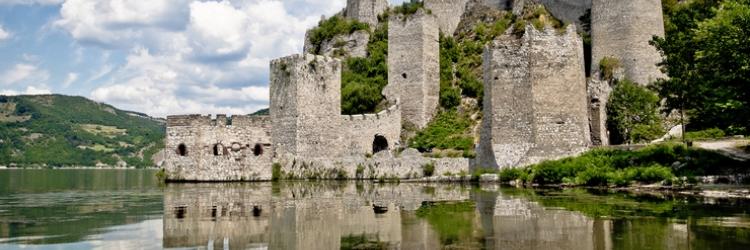Travel destinations Comments: 0 Sep 28, 2017
The Golubac Fortress was a medieval fortified town on the south side of the Danube River, 4 km downstream from the modern-day town of Golubac, Serbia. The fortress, which was most likely built during the 14th century, is split into three compounds which were built in stages. It has ten towers, most of which started square, and several of which received many-sided reinforcements with the advent of firearms.
Golubac, in the Braničevo District of north-eastern Serbia and on the modern-day border with Romania, marks the entrance to the Đerdap national park. It is strategically located on the embankment of the Danube River where it narrows to form the Iron Gate gorge, allowing for the regulation and taxation of traffic across and along the river. In the Middle Ages, this was done with the aid of a strong chain connected to Babakaj, a rock on the far side of the river.
Golubac Fortress has had a tumultuous history. Prior to its construction it was the site of a Roman settlement. During the Middle Ages, it became the object of many battles, especially between the Ottoman Empire and the Kingdom of Hungary. It changed hands repeatedly, passing between Turks, Bulgarians, Hungarians, Serbs, and Austrians, until 1867, when it was turned over to the Serbian Knez, Mihailo Obrenović III. Now, it is a popular tourist attraction in the region and a sightseeing point on Danube boat tours.
Golubac consists of three main compounds guarded by 10 towers and 2 portcullises, all connected by fortress walls 2–3 metres thick. In front of the fortress, the forward wall doubled as the outer wall of the moat, which connected to the Danube and was likely filled with water. A settlement for common people was situated in front of the wall.
As is the case with many fortresses, Golubac's structure was modified over time. For years, there were only five towers. Later, four more were added. The towers were all built as squares, a sign of the fortress' age, showing that battles were still fought with cold steel. Once firearms came into use, the Turks fortified the western towers with cannon ports and polygonal or cylindrical reinforcements up to two metres thick. After the Hungarian raid in 1481, they added the final tower, complete with cannon embrasures and galleries.
Considering the age and location of the Golubac Fortress, it is both large and well-preserved. Its placement at the head of the Iron Gate gorge allowed for easy control of river traffic. It was the last military outpost on that stretch of the Danube river, which caused it to frequently be part of the final line of defense between Hungary and the Ottoman Empire, especially during the periods when Serbia was Ottoman-held. The importance of the fortress is further indicated by the attention it received from Sigismund and Murad II, rather than just fighting between locals and commanders of nearby cities.
The Golubac Fortress was declared a Monument of Culture of Exceptional Importance in 1979, and it is protected by the Republic of Serbia.
How to get to Golubac by bus:


 RS
RS  ME
ME  HR
HR  BA
BA  RU
RU  MK
MK  AL
AL  ES
ES  DE
DE  IT
IT  CN
CN  NL
NL  SE
SE  FR
FR 






Write a comment